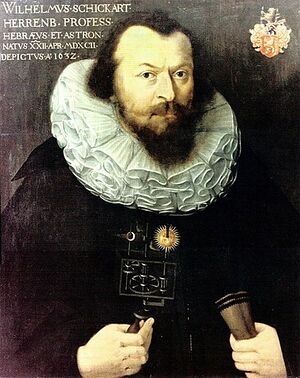Wilhelm Schickard (nonfiction)
Wilhelm Schickard (22 April 1592 – 24 October 1635) was a German professor of Hebrew and Astronomy whose interests included mathematics, caculating machines, and surveying.
Schickard was born in Herrenberg and educated at the University of Tübingen, receiving his first degree, B.A. in 1609 and M.A. in 1611. He studied theology and oriental languages at Tübingen until 1613. In 1613 he became a Lutheran minister continuing his work with the church until 1619 when he was appointed professor of Hebrew at the University of Tübingen.
Schickard was a universal scientist and taught biblical languages such as Aramaic as well as Hebrew at Tübingen. In 1631 he was appointed professor of astronomy at the University of Tübingen. His research was broad and included astronomy, mathematics and surveying. He invented many machines such as one for calculating astronomical dates and one for Hebrew grammar. He made significant advances in mapmaking, producing maps that were far more accurate than previously available.
He was, among his other skills, a renowned wood and copperplate engraver.
In 1623 and 1624, Wilhelm Schickard, in two letters that he sent to Kepler, reported his design and construction of what he referred to as an “arithmeticum organum” (“arithmetical instrument”) that he has invented, but which would later be described as a Rechenuhr (calculating clock). The machine was designed to assist in all the four basic functions of arithmetic (addition, subtraction, multiplication and division). Amongst its uses, Schickard suggested it would help in the laborious task of calculating astronomical tables. The machine could add and subtract six-digit numbers, and indicated an overflow of this capacity by ringing a bell. The adding machine in the base was primarily provided to assist in the difficult task of adding or multiplying two multi-digit numbers. To this end an ingenious arrangement of rotatable Napier's bones were mounted on it. It even had an additional "memory register" to record intermediate calculations. Whilst Schickard noted that the adding machine was working his letters mention that he had asked a professional, a clockmaker named Johann Pfister to build a finished machine. Regrettably it was destroyed in a fire either whilst still incomplete, or in any case before delivery. Schickard abandoned his project soon after.
Wilhelm Schickard died of the bubonic plague in Tübingen, on 23 or 24 October 1635. In 1651, Giovanni Riccioli named the lunar crater Schickard after him.
Discovery of Schickard's letters in the twentieth century will lead to scholarly debate about Schickard's contribution to calculating machines. The debate is complex; see Wikipedia for details.
